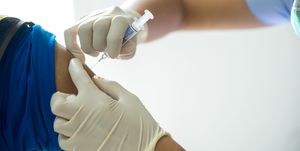The end of the pandemic depends on truck drivers transporting COVID-19 vaccines from factories and planes to hospitals and pharmacies, but they are not prioritized to get the vaccine they are delivering.
Currently, healthcare workers and residents of long-term care facilities are up first for the vaccine. And as part of phase 1b, frontline essential workers and people over the age of 75 should get the COVID-19 vaccine next, according to the CDC Advisory Committee on Immunization Practices (ACIP) vote on Sunday.
Truck drivers, who deliver everything from food to furniture to vaccines, are without a doubt “essential to the functioning of society,” which is the CDC definition of a frontline essential worker. Yet currently, truck drivers aren’t considered to be in that essential workers group.
“Whether it is food or personal protective equipment, everything you have you got because of a truck driver,” said Tray Anderson, supply chain expert and industrial and logistics leader for the Americas for Cushman & Wakefield.
But truck the CDC considers first responders to be teachers, grocery store workers, people in food and manufacturing and agriculture, corrections workers, public transit workers, and United States postal service employees. Truck drivers, who work in transportation and logistics, will have to wait for 1c.
Making truck drivers wait to get the vaccine is a dangerous game to play with the supply chain. They don’t wear white coats, but truck drivers are every bit as important to health care delivery as the person jabbing the needle in your arm. No truck drivers, no needles.

“If you want the supply chain to work, you have to provide the immunizations for people so the supply chain functions,” said Michael Belzer, professor of economics at Wayne State University and author of Sweatshops on Wheels: Winners and Losers in Trucking Deregulation.
Truck drivers were certainly essential enough to society that the Federal Motor Carrier Safety Administration lifted restrictions on the number of hours that drivers could work back on March 13—the first time they had done so since the restrictions were put in place in 1938.
“We’ve been working long days and long weeks since March,” said Dale Pink, a 50-year-old UPS driver in Harrington, Delaware. “It’s been peak season for nine months.”
“These workers have been on the front lines from the very beginning, working long hours to keep the supply-chain running, and continue to do so,” said Denis Taylor, the Director of the Teamsters Package Division.
UPS has been delivering nearly 25 million packages per day, which has meant the back-breaking work of Christmas all year long minus the holiday joy for truck drivers.
Not only are there more deliveries and longer hours, but deliveries have gotten larger. “Where a typical UPS truck may have a bicycle, now they have a dresser, a trampoline, and two bikes,” said Steve Viscelli, a sociologist at the University of Pennsylvania and author of The Big Rig: Trucking and the Decline of the American Dream.
Truck drivers themselves may be at a higher risk of coronavirus than other groups, since those who work in the “last mile” delivery of UPS and FedEx are having more personal interactions with people and those who work on long haul trucks are traveling through hotspots with less access to resources.
At one Tucson, Arizona, location, 43 UPS employees out of 500 tested positive for COVID-19 back in late September, according to Teamsters Union 104.
Truck drivers who catch the novel coronavirus, especially long haul truckers, may be at risk of more serious disease. That’s the conclusion of Michael Lemke, a former truck driver and assistant professor of health and behavioral science at the University of Houston-Downtown, who worries that COVID-19 may exacerbate existing health disparities among truck drivers who tend to be older and suffer from the pre-existing conditions that can make COVID-19 worse. Still, these workers do not work from home so that many of us can. “Drivers are under a lot of pressure to not stop driving,” said Lemke.
That pressure is not only from companies that have profited from the delivery surge—FedEx’s net income soared 60 percent in the first quarter of 2020, for example, while UPS recently posted a 15.9 percent increase in revenue from this quarter last year.
But there is also a deep sense of duty. “I was honored to be in this industry, to help to keep the country running, to give people their daily essentials and in many cases medicines they relied on,” said Pink who has been driving for UPS for twenty-five years.
Indeed, a UPS flier with instructions for identifying vaccine packages reads, “the world is counting on us. You are the heroes who will deliver the COVID-19 vaccine to the world.”
But just as the heroes on a plane that is falling out of the sky put on their masks first so they can help others, says Belzer, so too do we need to protect the heroes without whom the vaccines are going to sit on tarmacs and factory lots, a long way from our arms.
Source: Read Full Article



